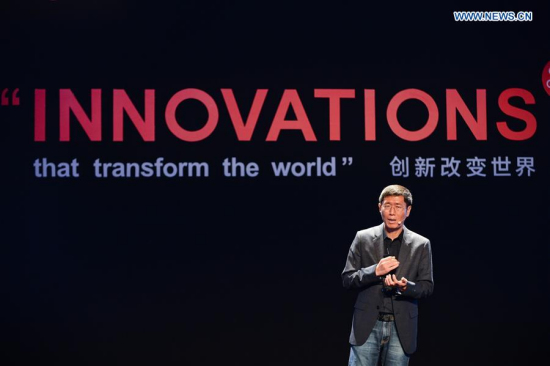
Liu De, co-founder and vice president of Xiaomi Corporation, a Chinese smartphone maker, makes a speech on a forum themed on "Innovations that transform the world" in Beijing, capital of China, July 22, 2016. (Xinhua/Qin Haishi)
Chinese cities, with their ubiquitous science and technology parks and entrepreneur roadshows, are fiercely competing to win reputations for accommodating business startups and mass innovation.
China is aiming to become an innovation powerhouse by 2020, according to a national program for science and technology that was recently adopted as part of the 13th Five-Year Plan for national socioeconomic development.
The plan, which Premier Li Keqiang said "fully demonstrates that we have given top priority to innovation," adds fresh impetus to a national movement of supporting and encouraging innovation since 2013.
So far, more than 200 makerspace projects, 1,600 business incubators, and 129 high-tech zones and science and technology parks have been created nationwide. They help concentrate resources for innovation and nurturing start-ups launched by business executives, scientific researchers and even college students.
"The local government has given much attention to and support for entrepreneurs," said Yang Rong, co-founder of XGimi Technology, a star tech start-up in the western Chinese city of Chengdu.
Her company has benefited from favorable government policies such as free work space, financial awards for patent approval, and communication platforms with global investors and entrepreneurs, which helped kick-start XGimi at an early stage.
In less than three years, the firm has grabbed more than half the market share for miniature, home-theater projectors in China, and shipped more items than the South Korean electronic giant LG, its main competitor in the global market.
According to data released by the local government, the total of newly registered enterprises jumped 34 percent in Chengdu in 2015 compared with the previous year, with the number of invention patent applications up by more than 35 percent in the same period.
CUTTING RED TAPE
China is undergoing a transition from a labor-intensive "Made in China" model to an innovation-driven "Created in China" model, Francis Gurry, director-general of the World Intellectual Property Organization, told Xinhua.
In the southern city of Shenzhen, high-tech manufacturing already accounts for 66.2 percent of the city's total industrial value-added income. Shenzhen switched to innovation earlier than other big cities, and has a free business environment, strong policy support for start-ups, as well as efficient venture capital.
Across China, local governments have taken the opportunity to deepen reforms, cut red tape and remove barriers to innovation.
Chengdu, for instance, has simplified its procedures for business registration, worked aggressively to protect intellectual property, and spearheaded reforms in universities to promote technology transfer and commercialization.


















































